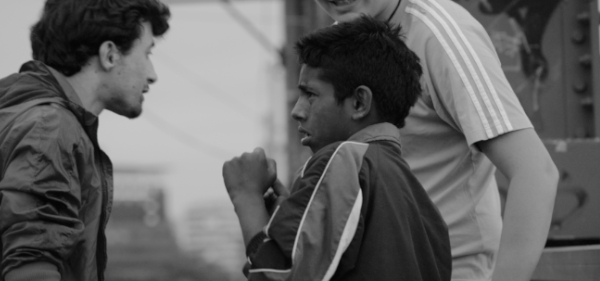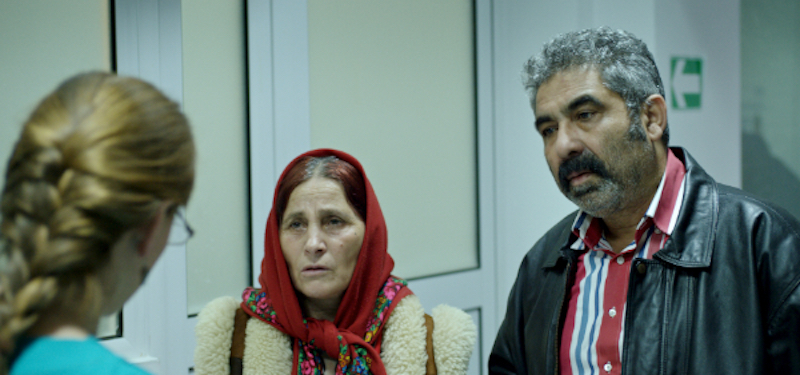Interview by Denisa Tomkova // Oct. 21, 2019
One of the curated sections at this year’s interfilm Festival will be focused on the Roma minority. The section ‘Europe Unknown: Roma4Life,’ curated by Hamze Bytyci, tells a story about the Roma from the perspective of Roma artists themselves, avoiding stereotypes and ‘othering.’ Bytyci is a Berlin-based documentary film director and theatre pedagogue. In 2011, he established the RomaTrial e.V. association and manages the online station Radio Corel. We spoke to Bytyci about his social and political commitment and engagement with the issue of Roma marginalization, and about the potential of art to challenge negative stereotypes.

Ivan Bukvić: ‘Mooch’, 2019, Film still // Courtesy of the artist and interfilm festival
Denisa Tomkova: For this year’s interfilm Festival you curated the film section focused on the Roma minority, entitled ‘Europe Unknown: Roma4Life.’ Can you please tell me more about the films you chose for this program?
Hamze Bytyci: The film selection is a trip through Europe from the perspective of Romani people in different countries: from Turkey, through Serbia and Romania to Czech Republic and the U.K. You can see Romani people in different life situations, which are—due to racist structures in the society and in the minds of people—often not easy.
The journey starts in Erdine, Turkey, where, for generations, the local Romani community has provided frogs for European delicatessen. The documentary ‘Frog Hunters’ portrays not only the every day work, but also the intergenerational dynamics and the ongoing pollution, threatening the traditional business. In the Serbian live action film ‘Mooch,’ you can follow a young boy who escaped a children’s home and lives in a tram depot. The Romanian live action film ‘Written/Unwritten’ shows to what an absurd situation an expired passport can lead, which seems funny at first sight, but causes severe problems in everyday life. In the documentary ‘It’s Hard to Talk About It,’ you meet a Romani family who has been attacked by neo-Nazis in their family house in a Czech town in 2009. The invaders threw a Molotov cocktail through the window, directly on a sleeping baby whose body was 80% burned. But the parents stayed strong and have more to say about the people who helped them than about the aggressors. In my personal favourite 4-minute documentary, the young Romani director Liza Mortimer claims ‘Take Us As We Are’: she uses archive material from 1969 to raise the question of whether all people have to be the same or if society is strong enough to allow diversity of lifestyles and values.

Adrian Silisteanu: ‘Written / unwritten’, 2016, Film still // Courtesy of the artist and interfilm festival
DT: Your devotion to social and political issues and especially making the issue of the marginalization of the Roma people more visible, has been part of your work more broadly. You founded the association RomaTrial e.V. in 2011. Can you please tell me more about its activities and objectives?
HB: RomaTrial is a transcultural organization of people with and without Romani origin. Our aim is combating racism and, in particular, Antigypsyism, by artistic means, as well as promoting Roma artists and creating space for them in public. I see RomaTrial as a platform for different voices from different Romani communities that are missing in our society. That’s why in 2017, I initiated the Festival of Romani Film ‘AKE DIKHEA?’. The next edition takes place from December 5th-9th, 2019. In 2018, we conducted the 1st Roma Biennale ‘Come Out Now,’ the first Biennale organized by and with Romani artists from all over Europe. The response was amazing. I think it was the first time the topic of Romani people got to the yellow press without negative connotations. Over four days, the Biennale was visited by 1,500 people! This year, we carry out the RomnjaJazz project, a support program for three wonderful female Jazz musicians Riah Knight, Matilda Leko and Tayo Awosusi-Onutor.
We also use different important days to draw attention to Romani people in Europe and to change the negative image we have. Since 2014, we have celebrated the International Day of Roma in cooperation with the Maxim Gorki Theater in Berlin, which is a great supporter. In 2015, together with the Foundation Memorial to the Murdered Jews of Europe, we initiated the Alliance for Solidarity with the Sinti and Roma of Europe, which now gathers 25 different organizations like Amnesty International, the Lesbian and Gay Association in Germany or the Central Council of Jews in Germany. Since 2016, we have organized the ‘RomaDay’ together with the Alliance. Since 2013, we have also organized an annual commemoration ceremony for the victims of genocide on Romani people on August 2nd. On this day in 1944, over 3,000 Sinti and Roma were murdered during one night in Auschwitz.
Our other fields of activities, besides art and culture, are youth and education as well as knowledge and politics. But, of course, lots of activities are overlapping from one field to another. For example, two Romani youngsters from Kosovo who participated in our summer film schools since 2015, have produced their own short film in 2018 and were selected for the film festival. This is a great success for us, to see that our activities are sustainable and that our work matters.
DT: The Roma are the largest European minority, which is, however, still hugely marginalized. Roma collective memory includes painful events such as the Roma and Sinti Holocaust, but even today some of the Roma communities still experience harsh living conditions in segregated housing with no access to safe drinking water, infrastructure or public services. How do you think art and film can raise awareness on these pressing issues?
HB: Everyone seems to have an image of “them”: of Sinti, Roma, Kale, Kalderash, Lovara, Lalleri, Ursari, Beash, Manouches, Askali, Aurari, Romanichals, Droma, Doma, Gypsies, Travellers and all other Romani groups of this world. When we started to look for films for the first edition of ‘AKE DIKHEA?’, we realized that many films about Romani people start with a pile of rubbish or naked children. A perfect mirror of the centuries old prejudices about “us.” And we have realized: we are sick and tired of criticizing well-intentioned, failed projects that only reinforce the stereotypes. Instead of putting a spotlight on examples of bad praxis, we have decided to support and produce images that are critical and reflective towards racist or colonialist perspectives. And we have filled a huge gap with this. The audience’s reactions are great. Cooperations, like the one with interfilm, show the lively interest in different images. This is the path we want to follow and hope will contribute to a more fair, free and democratic society.
DT: What message do you hope the audience of the ‘Europe Unknown: Roma4Life’ section will take away from the festival?
HB: It might sound strange but my biggest wish is that society finally sees Romani people as human beings. As individuals who are as individual, as diverse and as normal as all other people. As individuals who have their own dreams, needs, fears, weak and strong sides.
Festival Info
INTERFILM FESTIVAL
‘Europe Unknown: #Roma4Life’
Screening: Nov. 06, 2019; 8pm and Nov. 09, 2019; 6pm
Festival: Nov. 05 – Nov. 10, 2019
Admission: €7/8
Kino in der Königstadt, Straßburger Str. 55, 10405 Berlin, click here for map
Babylon 3, Rosa-Luxemburg-Str. 30, 10178 Berlin, click here for map


















